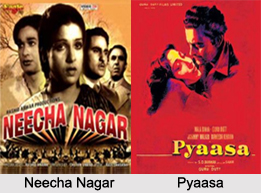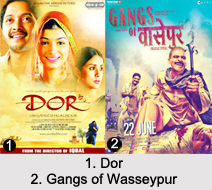 One of the earliest evidences of Parallel Cinema in the Hindi film industry traces back to the 1937 V. Shantaram-directed film ‘Duniya Na Mane’, a critical and commercial success that was showcased at the Venice International Film Festival and is hailed for "its daring attack on the treatment of women in Indian society" and depiction of child marriage. Another pioneering example of a socio-realistic Hindi film was Chetan Anand’s ‘Neecha Nagar’ (1946), the first Indian film to gain recognition at the Cannes Film Festival, after it shared the Best Film award at the festival’s first edition in 1946. A few early Hindi art films that ideally combined artistic and commercial elements include Bimal Roy’s ‘Do Bigha Zamin’ (1953) and Guru Dutt’s ‘Pyaasa’ (1957), both critical and commercial successes. Filmmakers Hrishikesh Mukherjee and Basu Chatterjee reflected middle-class lifestyle and ethos in their films.
One of the earliest evidences of Parallel Cinema in the Hindi film industry traces back to the 1937 V. Shantaram-directed film ‘Duniya Na Mane’, a critical and commercial success that was showcased at the Venice International Film Festival and is hailed for "its daring attack on the treatment of women in Indian society" and depiction of child marriage. Another pioneering example of a socio-realistic Hindi film was Chetan Anand’s ‘Neecha Nagar’ (1946), the first Indian film to gain recognition at the Cannes Film Festival, after it shared the Best Film award at the festival’s first edition in 1946. A few early Hindi art films that ideally combined artistic and commercial elements include Bimal Roy’s ‘Do Bigha Zamin’ (1953) and Guru Dutt’s ‘Pyaasa’ (1957), both critical and commercial successes. Filmmakers Hrishikesh Mukherjee and Basu Chatterjee reflected middle-class lifestyle and ethos in their films.Parallel Cinema grew in Bollywood to a much wider extent during the 70s and the 80s, with directors like Shyam Benegal, Kumar Shahani, Mani Kaul, Gulzar, Rajinder Singh Bedi, Kantilal Rathod, Saeed Akhtar Mirza and Govind Nihalini. The period also saw the emergence of young artistically adroit actors like Shabana Azmi, Smita Patil, Amol Palekar, Om Puri, Naseeruddin Shah, Kulbhushan Kharbanda, Pankaj Kapur, Deepti Naval and Farooq Sheikh. Notable parallel films of the time are ‘Uski Roti’ (1971), ‘Ashadh Ka Ek Din’ (1972), ‘Maya Darpan’ (1972), ‘Ankur’ (1974), ‘Bhumika’ (1977), ‘Aakrosh’ (1980), ‘Ardh Satya’ (1983), ‘Khayal Gatha’ (1989) and ‘Kasba’ (1990).

For more, visit the link below: